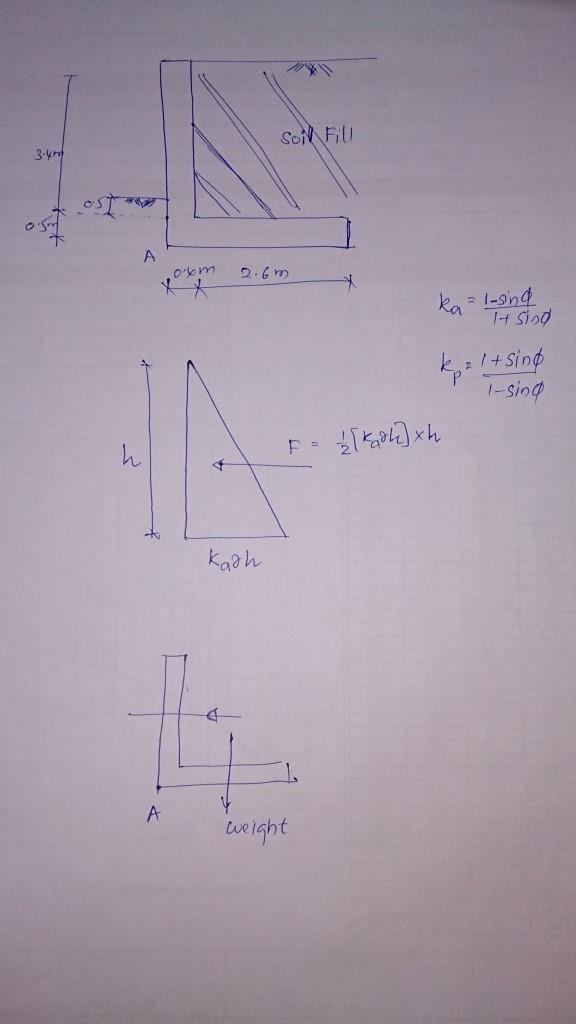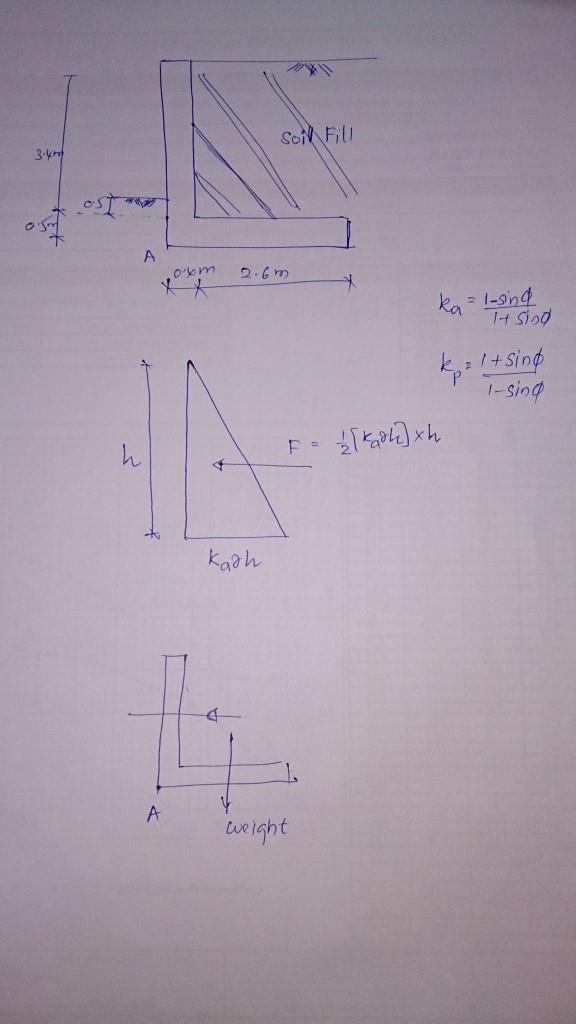Stability tests for retaining walls
Tipping and sliding tests are carried out to ensure the stability of retaining walls. Additionally, the base camp pressure is also checked to confirm that it is within limits. In this calculation we focus on the two stability tests: sliding and tipping.
Premises
- Ground friction angle 30
- Coefficient of friction between soil and concrete 0.5
- Soil dry density 18 kN/m 3
- The groundwater level is not taken into account in this calculation. (When considering water pressure, we need to consider the underwater unit weight of the soil and, depending on the capillary action of the soil, also the saturated unit weight of the soil.)
- To simplify the calculation, no additional loads are taken into account
Active ground pressure = (1 – Sinϕ) / (1 + Sinϕ)
= (1 – Sen30) / (1 + Sin30)
= 0.333
Passive soil pressure = (1 + Sinϕ) / (1 – Sinϕ)
= (1 + Sen30) / (1 – Sen30)
= 3.0


Check for tips
Pressure at the base = K A γ h
= 0.333 x 18 x 3.9
= 23.377kN/ m2
Lateral force = 0.5 × 23.377 × 3.9
= 45.584 kN
Weight of soil in the foundation = 2.6×3.4×18
= 159.12 kN
When the retaining wall falls, it rotates around point “A”. Therefore, the moment about point “A” is measured to determine the tipping moment and the restoration moment.
Breaking moment = 45.584 x 3.9/3
= 59.259 kN·m
Restoring torque = 159.12 x (2.6/2 +0.4)
= 270.504 kN·m
Actual safety factor = 270.504 / 59.259
= 4.565
It should be noted that the structure's own weight was not taken into account in this calculation. Even without the construction's own weight, there is a moment for greater restoration.
The safety factor against slipping is generally assumed to be 1.5. However, it may vary depending on the project requirements. Here the value is significantly above the required value. It can therefore be assumed that the resistance to tipping is satisfactory.
Slip test
The slip can be explained in two ways. To prevent the structure from sliding, the friction force between the soil and the concrete or the passive pressure generated by a shear wedge can be taken into account.
Case 01: Without shear anchor, only consider the friction between the soil and the concrete
The weight of the structure must be taken into account in this calculation, as it amplifies the reaction resulting in greater friction force.
Concrete density = 24 kN/m 3
Structure weight = (3.9×0.4 + 2.6×0.5)x24
= 68.64 kN
Total weight = floor weight + structure weight
= 159.12 + 68.64
= 227.76 kN
Assume a coefficient of friction between the soil and the concrete of 0.5. This value may vary depending on the nature of the soil.
Friction force = 0.5 x 227.76
= 113.88kN
Shear force = 45.584 kN
Safety factor = 113.88 / 45.584
= 2.5
We generally keep the safety factor around 1.5 against slipping. The actual safety factor is significantly higher than the permitted value. So swiping is fine.
Case 02: Supply of shear spring element
Some engineers are reluctant to use frictional force to prevent retaining walls from sliding because ground conditions can be variable and unpredictable. Furthermore, as the height of the retaining wall increases, the effect of passive pressure is generally taken into account. Although the above calculation is satisfactory for sliding, we can also proceed with this method to get an idea of the concept.
The height of the shear wedge can be determined as follows
Safety factor = Allowable sliding force / Actual sliding force
Allowable sliding force = FOS (actual sliding force)
0.5 (K P γ h) h = 1.5 x 45.584
H 2 = 1.5 x 45.584 / (0.5 K P γ)
= 1.5 x 45,584 / (0.5 x 3 x 18)
= 2.532
h = 1.6m
To create superimposed passive pressure, a soil layer height of 1.6 m is required if we assume complete mobilization of passive pressure and neglect friction under the foundation.
According to the figure above, the ground coverage above the base is 0.5m and the thickness of the base is 0.5m.
Impulse spring depth = 1.6 – 0.5 – 0.5
= 0.6m
Provide a cutting wedge with a height of 600 mm.
It also states that we need to check the pressure under the foundation and that it must be below the allowable bearing capacity of the soil.

